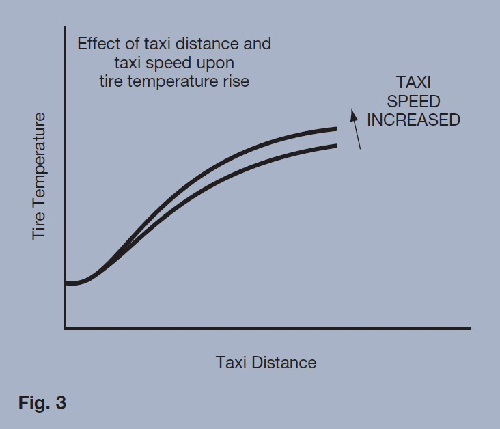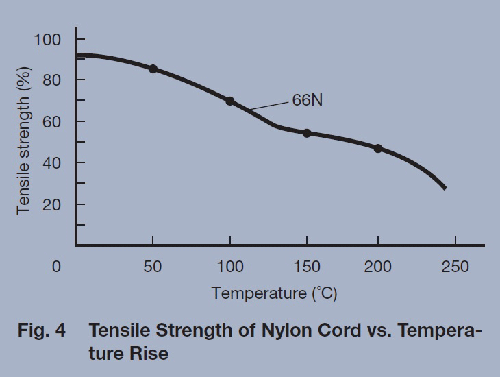Aircraft Tires
Care and Maintenance Tire Care and Maintenance
6. Caution in Taxiing
The aircraft tire generates heat in the body much more than car tires. This heat generation is considerably influenced by taxi distance and taxi speed.
If a taxi is done at extraordinary higher speed, or for unexpectedly longer distance, tire temperature becomes extremely high.
Such increases in temperature accelerate deterioration of nylon cords, shorten the serviceability of the carcass, increase wearing of the tread, and lower the adhesion between ply cords.

As shown by Figure 3, tire temperatures continue to rise as taxiing distances increase. Although these values differ depending upon the type of aircraft, the general trend is the same. Increases in taxiing distances cause increased deterioration in aircraft tires. Note that taxiing speeds are also a factor affecting increases in tire temperatures.

Figure 4 illustrates the trend in the influence that a combination of underinflation and increased deflection will have on internal heat build-up. Operating under such conditions may cause the tire to exceed tire temperature limits. As shown by the graph, nylon cord strength decreases as temperature rises.
7. Inspection After Landing
Aircraft tires should always be inspected for damage after each landing. The inspector must check carefully for evidence of cuts, bulges and blisters, severe cracking, slippage on the wheel, evidence of severe overheating and other types of tire failure. Removal criteria is contained in "Examination and Recommended Action" p55.
8. Normal Wear Removal Criteria
Extreme wearing of the tire may cause wet-skidding or hydroplaning, or may damage the tire. Therefore the tire should be removed at the following condition whichever comes first across the tread;
| ⅰ | When the wear level reaches the bottom of any groove at one point or up to 1/8 of the circumference. |
|---|---|
| ⅱ | The reinforcing fabric (bias) or aramid cord protector (radial) is exposed. |
If it is necessary to continue the tire in service beyond the limit i), the tire should be removed either at the next maintenance base or the limit ii) happens, whichever occurs first.
Important Notice:
Specific removal criteria shall be defined by instruction of airframe manufacturers, such as AMM. Such document takes precedence over this manual.
9. Removal due to Abnormal Use
If the tire is used under "abnormal operating condition", the tire must be removed from service immediately. Typical abnormal operating conditions are as listed below;
- Rejected take off
- Skidding due to break malfunction
- Over loading due to failure of axle mate tire (mate to flat)
- Low inflation pressure for a significant time period
- Hard landing
- Over speed take off or landing
If the tire undergoes those conditions, the tire is not serviceable even though there is no specific sign of damage in appearance.
It is strongly recommended for operators to inform Bridgestone of any tire removed for abnormal use, in order for us to take appropriate actions required for subject occurrence.
Category Link:
Tire Care and Maintenance
- 10. Removal by tire condition other than tread wear
11. Dismounting Bias Tires
12. Dismounting Radial Tires
13. Remounting of tires
14. Tire condition unsuitable for retreading - 15. Matching Tire Diameters
16. Tire Flat-spot
17. Protection from Contamination
18. Maintenance of Airport Surfaces - 19. Tires in Other than Aircraft Service
20. Storage of Tires
21. Handlings of tires
22. Transportation & Storage of Tire/Wheel Assemblies
23. Precautions during Unloading
24. Service Claim Memorandum

